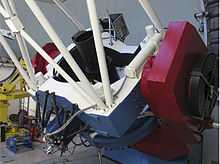Gamma-Ray Burst Optical/Near-Infrared Detector
"Grond" redirects here. For Grond, the fictional battering ram from J. R. R. Tolkien's legendarium, see the List of Middle-earth Weapons and Armour.

The GROND instrument mounted on the 2.2m telescope at the La Silla Observatory (lower left corner, blue cylinder).
The Gamma-Ray Burst Optical/Near-Infrared Detector (GROND) is an imaging instrument used to investigate Gamma-Ray Burst afterglows and do follow-up observations on transiting exoplanets. It is operated at the MPG 2.2m telescope at the La Silla Observatory.[1][2][3]
Discoveries
- On 13 September 2008, Swift detected gamma-ray burst 080913. GROND and VLT subsequently placed the GRB at 12.8 Gly distant, making it the most-distant GRB observed, as well as the second-most-distant object to be spectroscopically confirmed.[4][5]
- On 15 September 2008, NASA's Fermi Gamma-ray Space Telescope detected gamma-ray burst 080916C. On 19 February 2009, NASA announced that the GROND team's work shows that the GRB was the most energetic yet observed, and 12.2 Gly distant.[6][7]
See also
- Red shift observations in astronomy
- Photometry (astronomy)
- Max Planck Institute for Extraterrestrial Physics
Notes
References
- ↑ http://www.mpe.mpg.de/~saglia/journals_pdf/snellen2009.pdf
- ↑ http://www.aanda.org/articles/aa/full_html/2012/03/aa18336-11/aa18336-11.html
- ↑ "GROND Takes Off" (Press release). European Organisation for Astronomical Research in the Southern Hemisphere (ESO). 2007-07-06. Retrieved 2009-02-23.
- ↑ "NASA's Swift Catches Farthest Ever Gamma-Ray Burst" (Press release). NASA. 2008-09-19. Retrieved 2009-02-23.
- ↑ Greiner, Jochen et al. (2008-10-13). "GRB 080913 at redshift 6.7". arXiv:0810.2314.
- ↑ "NASA's Fermi Telescope Sees Most Extreme Gamma-ray Blast Yet" (Press release). NASA. 2009-02-19. Retrieved 2009-02-23.
- ↑ Greiner, Jochen et al. (2009-02-04). "The redshift and afterglow of the extremely energetic gamma-ray burst GRB 080916C". arXiv:0902.0761.